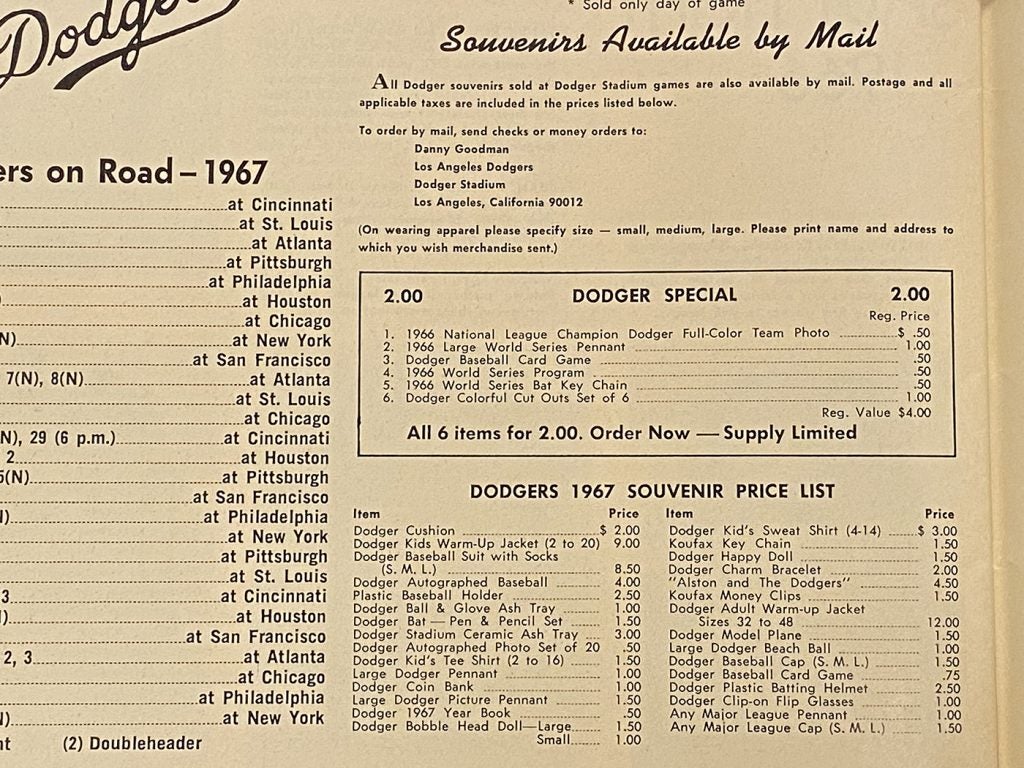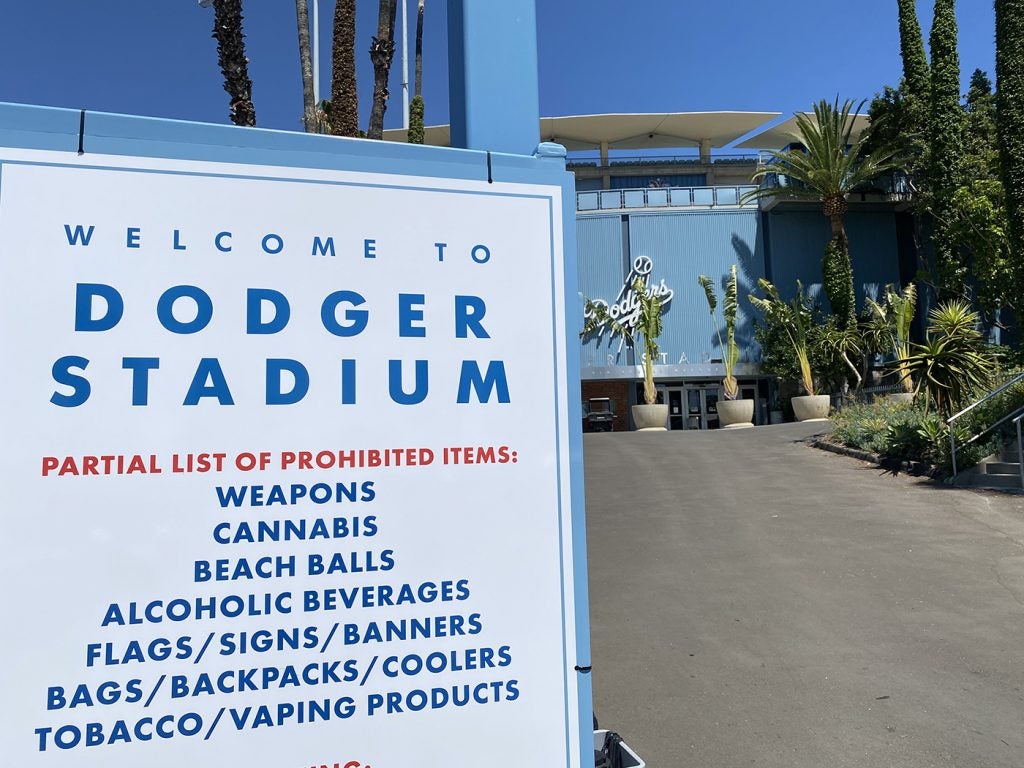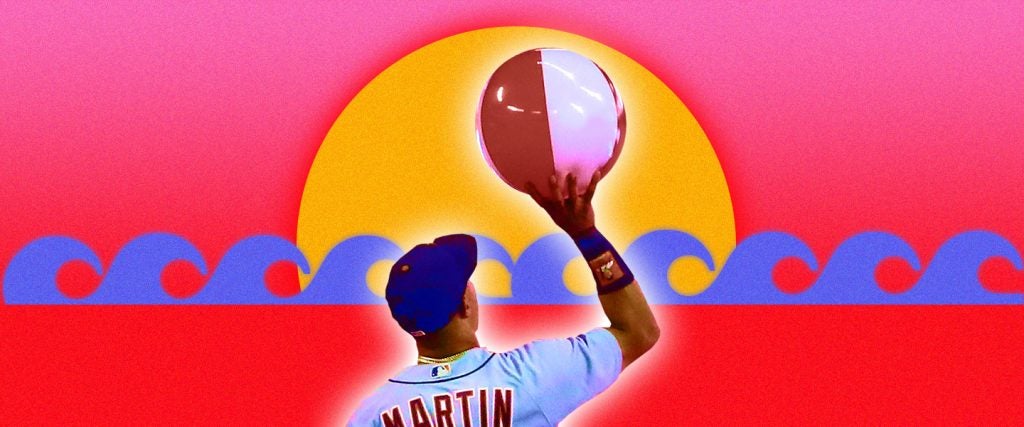It’s the week of Fourth of July. And while we appreciate you being here, we really hope it’s from some stretch of sand or some body of water relaxing enough that your problems can be put on the same kind of ice as the booze in the cooler next to you. If not, throw on your shades anyway, and join us for our weeklong package, “Life’s a Beach,” a celebration of all things sand, sun and summer. Of course, if you’re already on vacation, you’re welcome, too — just be sure to reapply another layer of sunscreen, as these pieces burn bright. Read all of them here.
Mark Langill has been the official historian for the Los Angeles Dodgers since 2002. The job usually requires him researching fans’ questions about arcane bits of Dodgers trivia, serving as the institutional memory of a ballclub that was first established in 1883, eventually moving from Brooklyn to L.A. in 1958. And yet, while he’s been asked lots of things about the Dodgers over the years, he swears that he’s never fielded a query like mine. “You’re the first guy to call about beach balls,” he laughs.
Baseball is a sport of traditions. The seventh-inning stretch. The singing of the National Anthem. And, depending on where you’re seeing a game, the familiar sight of beach balls bouncing around in the stands, fans gleefully bopping them to and fro, the inflatable diversions sailing through the air until gravity pushes them gently back down to earth, when they’re whacked yet again and sent skyward. Some people love the beach balls, some people hate them, but most agree the tradition started at Dodger Stadium, where the team started playing in 1962. (The Dodgers were at the Coliseum before then.) If anyone would know more, it would be Langill, a former sports reporter who covered the Dodgers and the author of Dodger Stadium.
Langill can’t tell me definitively when beach balls started flying around the ballpark, but he knows who was responsible for their initial popularity: an enterprising soul named Danny Goodman, who was the team’s director of concessions. “Danny Goodman was sort of [like] P.T. Barnum with a Hollywood rolodex,” Langill tells me over the phone as he sits at Dodger Stadium while the club is out of town. “When the Dodgers came here, he was a member of the Friars Club, and so immediately his rolodex gave the Dodgers a connection to Hollywood.” Indeed, below is a photo, believed to be from around 1964, with Goodman palling around with (from left to right) Stan Musial, Sandy Koufax, Willie Mays, Frank Sinatra and Dean Martin.
“Goodman was the one person that they hired when the Dodgers came from Brooklyn in 1958,” Langill says. “He’d been the concession director for the Pacific Coast League and the Flamingo Hotel.” Back in the 1930s, when Goodman still worked for a former New York Yankees farm club in Newark, he hit upon the idea of selling souvenirs, which was a novel notion at the time. “When the Dodgers first come out here, he puts the Dodgers script on everything — from glassware to kids’ pajamas. We were so far ahead of the game in terms of merchandising that it would make sense that eventually there’d be something called a Dodger beach ball.”
A natural-born salesman — when Goodman died in 1983, his epitaph in the directory of the star-laden Hillside Memorial Park mortuary read, “He is credited with virtually inventing the sports souvenir marketing industry” — he wasn’t the first to grasp that beach balls were effective publicity tools. In The Secret History of Balls: The Stories Behind the Things We Love to Catch, Whack, Throw, Kick, Bounce and Bat, journalist Josh Chetwynd notes, “In a 1924 Los Angeles Times advertisement, Harris & Frank department store offered ‘a big, light, seagoing ball’ if a customer purchased any knicker suit at its boys’ department. The L.A. Times must have found this type of inducement a smart business practice because during the 1930s the company gave a beach ball to any child who could persuade a friend or family member to buy a two-month Times subscription.”
Goodman wanted to sell the Dodgers to the movie stars of Southern California, but for the ordinary fan, he also envisioned a future in which the very experience of going to the ballpark would be exciting. “Why would anyone think it unusual to pick up a hat or a sweater when he’s at the ball game?” Goodman said in a 1962 interview with the L.A. Times. “They go to drugstores for everything from automobile tires to hardware as well as their medical supplies. Years ago, who would have expected luxury cafes and complete restaurants in the ballparks? I think eventually we’ll have full-scale shopping centers inside the parks. After all, we’re dealing with a captive audience for three or four hours. Eventually, we’ll be taking advantage of it.”
The man did indeed slap the Dodgers logo on everything. Langill sent me an image from the team’s 1967 catalog, which includes a Dodger Coin Bank, a Dodger Stadium Ceramic Ashtray, a Dodger Model Plane, a Dodger Bobble Head Doll — and also a Large Dodger Beach Ball. That last item cost a buck.

“That doesn’t mean that they marketed it in terms of, ‘Blow it up and bounce it around the stadium,’” Langill says. “Same thing as the Dodger lighter or [anything] that could have the Dodger logo on it — it didn’t mean to necessarily use it at the ballpark. It was just something that you were able to use for merchandise.” Langill couldn’t find any reference to the club selling beach balls in its first year at Dodger Stadium, but at some point between 1962 and 1967, the team began the practice. And sometime after that, fans started getting the idea of blowing up those beach balls and knocking them around in the stands during games.
When exactly did that happen? In his book The 34-Ton Bat: The Story of Baseball as Told Through Bobbleheads, Cracker Jacks, Jockstraps, Eye Black and 375 Other Strange and Unforgettable Objects, author Steve Rushin writes, “In the 1970s, when beach balls began to blight the field of play at Dodger Stadium, it killed Goodman to remove those items from sale at his stands, except that those stands were still heaving with every conceivable kind of product.” Langill can’t isolate an exact moment when a beach ball was first floating around in the ballpark, but he does say, “It’s definitely never been something that’s been promoted as part of the game experience. Sometimes I’ll listen to old broadcasts on YouTube, and it’s nice to all of a sudden listen to some game from 1973, and you can hear Vinny tell stories and then — just in the course of conversation — he says, ‘The usher took the beach ball, and he’s getting booed.’”
“Vinny,” of course, is Vin Scully, the Dodgers’ beloved longtime radio and TV sportscaster, a man as synonymous with the team as any of its Hall of Fame players. (Early on, Goodman also knew how to incorporate Scully into the team’s promotions: After a 1965 perfect game tossed by Sandy Koufax, he sold Scully’s broadcast of the rare pitching feat as a mail-order keepsake.) Like Scully, beach balls in the stands would become just as identified with the L.A. club, an unofficial symbol of what was great but also risible about baseball in Southern California.
On the plus side, those inflatables evoked paradisical images of L.A.’s incredible beaches and laid-back culture, suggesting a lighthearted attitude around the sport, as if the game was just part of the atmosphere of going to the ballpark. And it wasn’t just baseball games when the beach balls would start popping up at Dodger Stadium. “Pat K.,” an Elton John fan who attended his iconic sold-out shows at the stadium in October 1975, recalled years later, “Half dressed teens and young adults were partying away, determined to enjoy every minute till Elton appeared. Beach balls and people being bounced here and there, programs and T-shirts being hawked, and the smell of marijuana wafting every which way.”

Even though the Dodgers stopped selling beach balls, that didn’t stop fans from bringing their own, despite stadium rules that the items weren’t permitted. “It’s not going to set off a metal detector,” Langill admits about contraband beach balls that get smuggled into games. “It’s the honor system, but it’s the same thing in terms of [going to] the gift shop and buying a baseball — you shouldn’t have to have a sign that says, ‘Please don’t throw baseballs on the field.’”
But as Langill knows all too well, that very thing happened at a 1995 game at Dodger Stadium when the home fans, so enraged at umpire Jim Quick’s calling of balls and strikes, started throwing that evening’s commemorative giveaway onto the field, resulting in the Dodgers having to forfeit. “That was the last time we ever gave out baseballs,” says Langill. “A couple bad calls, one [baseball] flies out of the stands, and then suddenly 50,000 people get an idea.”
The Dodgers weren’t the only club to give out balls in the 1990s. Their hated rivals the San Francisco Giants handed them out before a 1993 game, with the balls eventually coming raining down from the stands. “Giving out baseballs was a bad idea,” umpire Bruce Froemming said at the time. “Why not give them hand grenades?’” So, by comparison, beach balls are pretty harmless — plus, they’re easy to sneak into a stadium undetected if you leave them uninflated. (Also, they’re cheap, easily attainable at any 99 Cents Only Store, which is good since you’re going to be parting with them in short order.) As long as you don’t get caught blowing up a beach ball, you can quickly smack it into the air, where it will land far enough away for another fan to hit it, sending the ball in a completely different direction. (In other words, the original culprit is hard to locate and punish.)
Because beach balls are mostly a benign diversion — unless you hit it right at someone’s head or it falls onto the field, forcing the game to be delayed — their existence at the ballpark is a victimless crime, a teensy bit of spontaneous playfulness amidst the occasional monotony of baseball. They’re the human equivalent of the ball of string meant to keep your cat entertained: We all like watching something flying around that maybe we can hit. Even Langill acknowledges there’s not a lot that ballpark security can do to crack down on the phenomenon.
“All you can do is just try to get the ball as quickly as possible so it doesn’t become a distraction for the fans for safety issues,” he says. “It’s just a matter of trying to get the beach ball and [being] done with it because, normally, somebody’s not going to be sitting there holding the beach ball — that would be a unique look. Normally, if somebody’s got a beach ball, chances are they’re only going to have it for about two seconds and then hit it in the air. But once it goes on the field, then the umpires all yell time, because the last thing you want is a beach ball becoming part of a play.”
Beach balls happen at other stadiums now, too — and in other sports — but because it’s so associated with Dodger Stadium, fans who hate the tradition tend to add it to the litany of things they despise about the Dodgers, or L.A. in general. Paul Daugherty, a sportswriter in Cincinnati, one of the most passionate baseball cities in the country, once wrote proudly of his town, “Baseball is not a diversion here. It’s not some beer-drinking, beach ball-bopping party. Other places, people go to baseball games the way they go to a movie. … They don’t take the game personally. We take it personally.”
The negative stereotypes about Dodger fans — they come to the game late, they leave early, they’re fair-weather, they’re easily wowed by superficial spectacle — are all exacerbated by the appearance of beach balls in the stands.
Even L.A. sports fans can get annoyed with the fad. Chetwynd writes in The Secret History of Balls, “A 1975 Pasadena Star News report lamented how multiple beach balls in the stands dominated attention despite a Dodgers 5-0 victory over the Atlanta Braves. Still, L.A. starting pitcher Don Sutton had a sense of humor about the distraction. ‘At least I got my hands on two beach balls that floated down — and my youngsters will have them in the morning,’ he quipped.” And Scully would sometimes let his irritation show about beach balls — especially when they put in an appearance during a crucial moment in the game. In a 2010 matchup against the Philadelphia Phillies, Dodger pitcher Hiroki Kuroda had a no-hitter going into the 8th inning when time had to be called because of an errant beach ball on the field. Scully got (slightly) peeved during the broadcast, saying, “And time, there’s a beach ball out there. You talk about bad timing. … And the crowd’s annoyed. Talk about a dull feeling for the dramatic. You throw a beach ball out on the field now, in the 8th inning? Wow.”
Soon after, the Phillies got their first hit of the game, inciting the rancor of baseball purists who assumed that Kuroda’s mojo was short-circuited because of the beach ball interruption.
Langill downplays beach balls’ official connection to Dodger Stadium and the team itself. “It wasn’t one of those things where it was a tradition, like a Dodger Dog or anything like that,” he says. “It was just a byproduct of the festiveness of a great game or a great pennant race, but it was never really sanctioned. You never see in any of the [promotional] literature, ‘Folks, come to the ballpark, bring your family, bring your beach ball, have fun.’” That said, he unsurprisingly pushes back against the notion that spectators’ fondness for beach balls indicates they’re an unserious fan base.
“It’s the La La Land [perception],” he says, “because you get more of the Hollywood [element] as far as the stars and the lifestyle and the sunglasses and what happens after a game — they’ll play Randy Newman’s, ‘I Love L.A.,’ which has the convertible-at-the-beach scene [in the video].” But deep down, I suspect Langill really doesn’t care if baseball fans in other parts of the country make fun of the good weather and Hollywood lifestyle that’s associated with the Dodgers. “I’m sitting here talking to you, and I’m looking outside,” he tells me from the team’s gorgeous ballpark. “I’m on the club level — I’m looking at palm trees, I’m looking at a nice sunny day.”
Still, the Dodgers probably can’t escape their fate as being known as the team that helped give the sport the striking, slightly silly image of beach balls in the stands. The impression is so solidified in baseball culture that MLB The Show even has beach balls cause interruptions at Dodger Stadium.
As a lifelong baseball fan — as one of those people who goes to the park to actually watch the game, not waste a lot of time with the sideshow attractions that are now so central to the stadium experience — I can’t say I love the beach balls. They can feel like the paper airplane that casually drifts through the air in a classroom, an annoying, bratty distraction meant to interrupt what’s supposed to be the focus. But then again, they’re also a bit of whimsical randomness injected into a game so full of traditions that the sport can feel preordained, rote, even precious. But like Langill, I just really hate it when they get on the field, ruining everything. If you want to bring a beach ball, fine, but don’t mess with the players — be smart enough to know where you’re hitting the damn thing so we don’t have to pause the game because of your dumb ass.
Langill is fairly politic during our conversation about beach balls. So finally, I ask him, What does he like better at the ballpark: the wave or beach balls?
“I’m more of a wave guy,” he tells me, “because the wave reminds me of the Billy Crystal movie” — When Harry Met Sally — “where he’s sitting there in the stands complaining about life to his two friends and he’s all depressed, but right in the middle of the wave, they all jump up and do it like it’s something they have to do. That’s something that at least you’ve got notice [is about to happen], and you’re still facing the field and all you’re doing is putting your hand in the air — you’re not doing something to somebody else. You’ve never had a game delayed because of a wave.”

